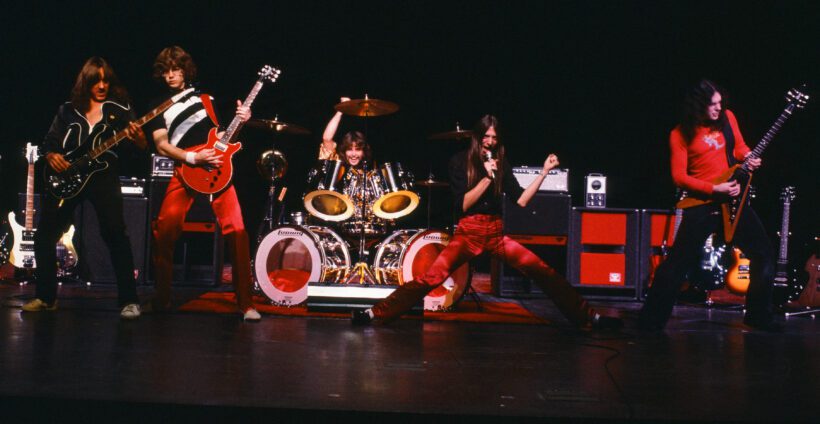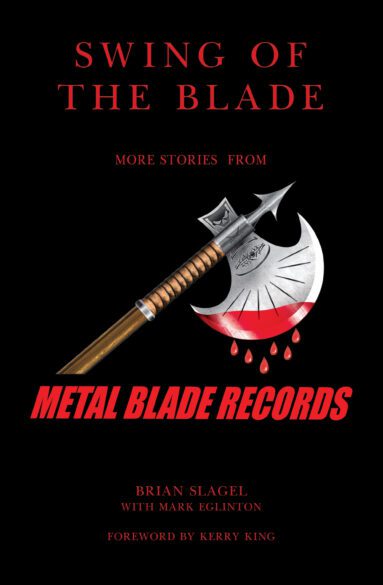
OK, we may have jumped the gun in suggesting that our previous exclusive excerpt from Metal Blade Records founder Brian Slagel’s upcoming book, Swing of the Blade: More Stories from Metal Blade Records was our final teaser. We, in fact, have a couple more leading up to its May 9 release. This week we go way back in U.S. metal history to the pre-Metallica days, when a Ventura, CA band called Cirith Ungol were the heaviest band in Southern California. Check out a portion of “From the Underground,” and if you want to read more, you can preorder Swing of the Blade here).

From the Underground
To this day, nothing makes me happier than when a band reforms and makes new music years after their original career. I’ve always considered seemingly lost causes to be a personal challenge. That is what keeps the genre going, and that, as everyone should know by now, is one of the primary reasons I ever got into this business in the first place.
There are many such acts, but one I constantly get asked about is Cirith Ungol. It feels like there’s always been a degree of mysticism surrounding them, probably because, even in their heyday, they never quite conformed to any specific scene. From a commercial standpoint, that uniqueness probably hindered them. But for me, their quirkiness has always been a big part of their appeal.
I first became aware of them around the time when I was looking for contributors for the first Metal Massacre compilation. Sometime in 1981, while I was working in the record store, somebody came in and said, “Hey there’s this band from Ventura called Cirith Ungol. They have an album out.”
“What?” I said.
“ . . . And it’s kinda heavy,” they added.
“Whaaat?” What was initially interesting about the band was that they were from Ventura, an hour or so north of L.A. Ventura at the time was just a sleepy little town that I knew well because my grandmother and aunt both lived there, so when I was a kid we’d drive up regularly to hang out for Christmas or Thanksgiving. In those days there was just a two-lane highway, one in each direction, from Thousand Oaks on the north side of L.A., to Ventura. There was nothing really up there at that time other than the beach. I knew the place, and now this band appeared, seemingly out of nowhere.
At that moment it made no sense to me that (a) there could even be a heavy band out of a place like Ventura, and (b) that I hadn’t already heard of them. Anyway, I did a bit of digging around and found that the guy was right. They’d released a record on what was essentially their own label, Liquid Fire Records, and Greenworld was distributing it.
I got ahold of the record, Frost and Fire, and found it immediately interesting. Yes it was heavy, but it was kind of hippie and avant-garde also. Something about their whole vibe was undeniably cool, but beyond that I really couldn’t put my finger on what was there.
After a bit of further research I learned that somehow they’d managed to get this record done in 1980 because one of the guys in the band either worked in a studio or his dad owned it—I can’t recall which. Either way, they clearly had a bit of money and the means, which was honestly half the battle. Not just that, and this still boggles my mind to this day, somehow they persuaded Michael Whelan, this incredibly famous artist in the field of imaginative realism, to let them, an unknown band, use one of his paintings for their debut album cover.
They told me the story years later, but at the time apparently they just wrote him a letter saying something along the lines of, “Hey, we’re this band from Ventura. Can we use one of your paintings?”
For whatever reason he replied saying, “Sure!”
It was a real coup. To this day I have no idea how they pulled it off. The cover for that record was frickin’ awesome.
I got in touch with them, became friends, and started trying to integrate them into the L.A .scene a little. To do this, however, was no easy task. They didn’t really fit in anywhere. Each individual in the band certainly had a unique look, but it wasn’t necessarily a metal look. They had a brilliant guitar player, Jerry Fogle (who has since sadly passed away) who was some kind of savant. He was unbelievably reserved and said almost no words. In the years that I knew him, if he spoke 100 words total, I’d be surprised. Because he was so socially awkward, he’d get very nervous onstage. Similarly, their drummer, Rob Garven, also got really anxious when playing live and would play very lightly because of that.
As great as their music was, because of their various personality quirks, they just weren’t a powerhouse live act back in those early days. Regardless of the challenges, throughout the early ‘80s I was continually trying to book them to open for other bands on the label, having had them contribute a song, “Death Of The Sun,” for the first Metal Massacre compilation album.
I remember one particular occasion when they opened for Armored Saint at the Country Club in Reseda. That night exemplified the challenges. It was a sold-out show and they played great, but at the same time it was obvious that the majority of the audience that night had no clue whatsoever how to respond to them. A few had their arms in the air for sure, but the rest just stood there staring. That’s how it often was with Cirith Ungol. Playing live just was not their strong suit and I’m not sure that they ever formally toured. They also had good, regular jobs as backup.
Their second album, King Of The Dead, released in 1984, is one of my very favorite records of the time. I love everything about that album: the progressive sensibilities, Tim Baker’s incredible vocals and, of course, all the wider imagery that surrounded them courtesy of yet another Michael Whelan album cover design. I loved everything about the Cirith Ungol world. The imaging was awesome and the music was great.
Again they recorded it themselves up in Ventura, and this time it was released on the Enigma label—an entirely fitting home given how much of an enigma the band really was. But as much a fan as I was, people still couldn’t get into them. They couldn’t really hang in the L.A. scene, East Coast people didn’t get them, they didn’t fit into the San Francisco scene either, and Europe certainly didn’t relate to them at that moment. To me it was all so frustrating. As was often the case with niche bands, I wanted everyone to love them like I did.
I didn’t let it go. I somehow persuaded them to come to Metal Blade to record their next two albums, 1986’s One Foot In Hell and 1991’s Paradise Lost, but by that point they’d become, through no fault of their own, even more of an outlier band than they already had been, as well as the records were received.
By 1986, the L.A. hair metal scene was well underway, and then the counterbalance to that was the thrash movement, which was gathering pace in parallel. Neither of those provided any sort of logical home for a band like Cirith Ungol, and it never helped that they weren’t particularly active from a live perspective. It felt like they just got swept away in everything.
With no formal management and only drummer Rob Garven looking after the business side of things, they became directionless, disillusioned and returned to their regular jobs when it became clear how tough the ’90s were going to be for all metal bands, far less a niche gem like Cirith Ungol. As always, I was left with this overwhelming sense of disappointment on their behalf. I felt that they deserved to achieve a status on a par with bands like Fates Warning or Armored Saint. But it just wasn’t to be.
Over the years, I kept in touch with the guys, until, in around 2000, their catalogue became available when Rob Garven and bass player Greg Lindstrom decided that they wanted to do something with all the original master tapes before they deteriorated to the extent that they couldn’t be used at all.
That was the initial opportunity we needed and so in 2001 in Europe, via the German office, we released Servants Of Chaos—a double compilation of live recordings and unreleased demos. It was later re-released worldwide and included a bonus DVD.
The timing could hardly have been better. When the whole metal resurgence took place on the back of the metalcore movement in the early 2000s, where all the classic metal bands were launched back into the forefront of the genre, suddenly I started seeing this really interesting buzz surrounding old-school metal bands, particularly from the kids in Europe. I remember going to a festival in Europe and seeing 16-year-old kids wearing Cirith Ungol T-shirts. Wow, that is fucking cool! I thought. Cirith Ungol was one of the bands that really struck a chord with these people and so, bit-by-bit, they started transforming into an important, beloved band with a cult following.
To read the rest of the “From the Underground” chapter, order Swing of the Blade here.


